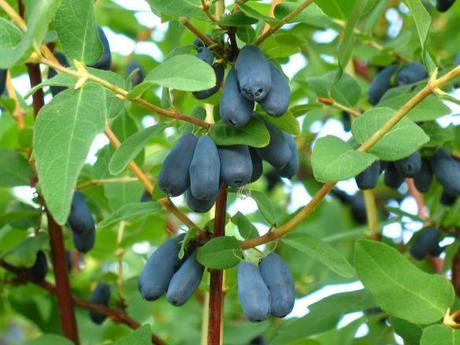In addition to lingonberries, my recent purchase of unusual fruiting plants included honeyberries.
Honeyberries are an edible honeysuckle, Lonicera caerulea. These plants live for up to 50 years, producing elongated sweet blue berries on year-old wood. Hardy in USDA Zones 3-8, they flower in early spring. The flowers are hardy to 20F. Honeyberries grow to 4-5 feet tall and wide, adapt well to a range of soil pH, resist most pests and diseases, and require two varieties for cross-pollination. I am growing varieties ‘Blue Moon’ and ‘Blue Velvet,’ which are late-flowering varieties suited for the American South. I’m expecting harvest time to occur at or slightly before strawberry season next year.

Honeyberries. Photo courtesy of North Dakota State University, http://www.ag.ndsu.edu/news/newsreleases/2010/june-21-2010/fruit-project-featured-at-carrington-center-field-day
As I try to increase the amount of food I grow for myself and my family, I must find ways to integrate the food crops attractively into the non-edible landscape. Because honeyberries grow in sun or shade, and prefer some shade in hot weather, I’ve sited these plants as the anchors on one end of a new bed on the north side of the house extension we completed last fall. They’ll receive morning sun, bright shade during the hottest part of the day, and some direct sun in early evening. In the winter and early spring, daffodils will bloom around their bare branches. I hope they’ll find this site appealing.
I first heard about these unusual fruits in a book by Mark Diacono, who gardens and writes about food from his smallholding (a small farm), Otter Farm (also known as the “Climate Change Farm”). He also gardens at River Cottage, a beacon of sustainable food in the UK.
I’ve never tasted honeyberries, but they’re said to taste like blueberries, raspberries, or saskatoons (another plant in my future). Whatever they resemble, I’ve never met an edible berry completely lacking in redeemable qualities. I do love the idea of growing fruits I can’t find at local markets, and experimenting with them in cooking.
I expect my only real challenge in growing honeyberries will be defending the harvest from the birds. My search for elegant netting solutions endures.

